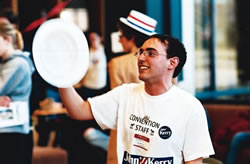 |
 |
 |
||||
 |
|
Before long, the mock proceeding took on the combative atmosphere of the real thing. “We had a field house full of 1,300 delegates who were yelling and screaming and arguing,” recalls head organizer Bill McClintock ’68. The Rockefeller forces had begun to line up votes before the balloting began. One target was a large swing delegation headed by a freshman. By then, the Rockefeller team had gone high tech, acquiring walkie-talkies for two-way communication on the convention floor.
Zitrin approached the freshman and offered him a walkie-talkie and the designation Rocky Two. Zitrin himself was Rocky One. When the convention began, Zitrin began to get messages from the freshman that began “Rocky Two to Rocky One, OVER.” “He was so thrilled that he delivered his whole delegation to Rockefeller,” Zitrin recalls. Still, Nixon took the first two ballots, though he fell short of the votes needed for the nomination. Rockefeller was still in the race, but he needed more votes. His team landed them with a very big horse trade. “We cut a deal to make Reagan the vice presidential candidate in return for his support,” Zitrin says. “It was pretty much a bald-faced political deal. It had to do with expediency and thus replicated real life.” On the third vote, Rockefeller went over the top with 715 delegates. In the actual Republican convention, Nixon breezed to his party’s nomination and picked Spiro Agnew, the nearly unknown Maryland governor, as his running mate. But the real fireworks that year would take place at the Democratic Convention in Chicago, amidst bloody confrontations between police and antiwar demonstrators. “Little did we know the previous fall that the Democrats would have the exciting convention, and the Republicans would be boring,” says Zitrin. |
